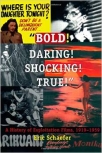After my first post on this topic the other day, I did a little more thinking about the whole "killer on the road" phenomenon. Billy Cook was certainly not the first embodiment of the Killer on the Road, and he certainly wasn't the last, but he sank into obscurity faster than the musical career of The Hollywood Argyles.
So why did his crime spree fall into oblivion while that of Charles Starkweather, almost exactly seven years later and similar in a lot of ways, become world famous and develop such a lasting endurance that he would be the topic of eight movies over the next 30 years -- including the Martin Sheen-Cissy Spacek vehicle Badlands from 1974 and the "eighth most controversial film of all time", Oliver Stone's neo-noir Natural Born Killers from 1991, not to mention the 1982 moody Bruce Springsteen hit, "Nebraska"?
Aside from Starkweather's first killing, on Nov 30, 1957 (which no one even connected with Starkweather until he confessed after his arrest), his killing spree lasted only eight days, from January 21 to January 29, 1958. His body count was higher, but not all that much higher -- only eleven people as compared to Cook's five. That's kind of paltry when it's compared to later killers such as Ted Bundy (at least 30 victims) or the now forgotten "I-5 Killer", Roger Kibbe (also known as "Roger Who?"), whose suspected number of victims also runs into the 30s.
So how did Charles Starkweather pull off that notoriety when Billy Cook couldn't? What happened during that seven year interim to make Starkweather's story develop the"legs" to be such a long-lasting part of our culture, our psyche?
Part of it goes to the breathlessly-reported sordid detail that Starkweather had his 14-year-old girlfriend, Caril Ann Fugate, with him the whole time, after first murdering her entire family (shades of Mickey and Mallory Knox!), and the fact that they had terrorized and then murdered a wealthy local industrialist along with his wife and their maid, in their own home!. To the media, a wealthy person's violent death, especially in a home invasion, is worth far more than that of the "Poor White Trash" represented by Caril Ann's family, and consequently that crime gets way more air play and more column inches in the reporting. But that's only part of the story.
What happened in just seven short years comes down to two things: The advent of universal access to television by "the masses", and rise of the Juvenile Delinquent.
In 1951, when Billy Cook made his run, television was something that only the well-to-do had. TVs were expensive, there were relatively few broadcasters, and the general feeling in the entertainment world was that after the novelty wore off, no one would really watch television -- in the words of movie mogul Darryl F. Zanuck, people would soon get tired of staring at a plywood box in their living rooms. By 1957, however, everyone except a few Luddite curmudgeons and cousin-marryin' moonshinin' backwoods-livin' peckerheads had a television set, and it was rapidly becoming THE source for the news of the world. Including news of a violence-prone Juvenile Delinquent serial killer roaming the highways in search of victims.
Anyone who lived through the 50s remembers the archetypal Juvenile Delinquent: Black leather jacket, Levi's, engineer boots, ducktail haircut, long sideburns, bad attitude, lack of respect for authority, cigarette dangling from snarly lips, etc. No, not the emasculated sitcom version epitomized in the pseudo-cool of Henry Winkler's "The Fonz" on the Happy Days TV series. The real JD was dangerous, unpredictable, bristling with switchblade knives and and bubbling over with barely-contained violence. According to the media's stereotypical portrayal of him, anyway.
It was also the media's frantic obsession with "Troubled Youth" (and coincidentally the market share it represented). Starting in the early 1950s, analyzing and explaining the Troubled Youth of the nation became a kind of cottage industry, and television coverage of youth crimes only served to exacerbate that trend.
First comic books were blamed -- they were solely responsible for the increase in teenage delinquency, an accusation that came from the questionable "science" of one Dr. Fredric Wertham and his crusade to have all comic books banned.
Then it was movies. Then it was television itself. Every print media outlet, from The New York Times to Life Magazine to Reader's Digest was wringing its collective editorial hands over the sudden juvenile "crime wave" that had swept up American Youth in its ugly paws. Even the newspaper comics' Dick Tracy got into the act in 1956, in a story arc concerning a punk named "Joe Period" who fit the classic mold -- ducktail haircut, black leather jacket, etc. -- which immediately morphed into a story concerning the murderously violent teenage genius offspring of one of Tracy's most classic villains, 1944's Flattop, one Flattop Jr. by name.
The 1955 release of Nicholas Ray's homage to rebellious youth, Rebel Without a Cause, starring the very symbol of teenage angst, James Dean (despite the fact that he was 24), hit the youth culture like a tidal wave combined with an earthquake combined with a meteor strike. Charles Starkweather even started modeling himself after the rebellious Dean.
The media were, naturally, quick to pick up on this trend and a ton of Teen Rebellion movies were produced, from the middle-of-the-road Blackboard Jungle to quickie crime-car-culture exploitation films like Hotrod Gang and its cult-classic sequel, The Ghost of Dragstrip Hollow, all of them cashing in on the perceived personal danger inherent in just being around a teenager in 1950s America.
So in 1958 it all came together, and a nation was glued to the little screen for over a week in late January, following the "exploits" of America's new favorite Juvenile Delinquent/spree killer, Charles Starkweather.
Sorry, Billy Cook. Timing is everything.
Oh, and that sudden increase in crime by "Juvenile Delinquents" in the 1950s? It never happened.
Friday, December 26, 2014
Killer on the Road, Part II -- Charles Starkweather
Posted by Farnsworth68 at 7:47 AM
Labels: Crime, media, spree killing











0 Comments:
Post a Comment